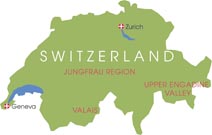Bernina Express - a train ride from Swiss glaciers to Italian palms
 Chur, Switzerland - Icy Alpine streams, jagged peaks and lovely landscapes - all this and more awaits passengers on the Rhaetian Railway's Bernina Express. Beginning its journey in Chur, capital of the Swiss canton of Graubuenden, the train winds its way up the Alps to the Bernina Pass, more than 2,000 metres above sea level. While passengers are still admiring the 4,049-metre peak known as Piz Bernina, the train starts its steep descent into the mild climate of Italy's Valtellina, an Alpine valley.
Chur, Switzerland - Icy Alpine streams, jagged peaks and lovely landscapes - all this and more awaits passengers on the Rhaetian Railway's Bernina Express. Beginning its journey in Chur, capital of the Swiss canton of Graubuenden, the train winds its way up the Alps to the Bernina Pass, more than 2,000 metres above sea level. While passengers are still admiring the 4,049-metre peak known as Piz Bernina, the train starts its steep descent into the mild climate of Italy's Valtellina, an Alpine valley.
The Bernina Express not only rolls through beautiful contrasting scenery, it is also a treat for technically-minded railway fans. The route has a gradient of 7 per cent, making it one of the steepest stretches of track in the world without rack rails, cables or other engineering tricks.
The trip from Switzerland to Italy on the single-track, narrow-gauge line takes just four hours despite the difficult terrain. Apart from the steep gradient, there are 196 bridges and 55 tunnels. Some of the structures are real eye-catchers that have passengers peering out of the observation cars in fascination.
Near Filisur, a Swiss village in the Engadine valley, a 136-metre-long viaduct abruptly ends at a sheer rock face. But the train rolls on - in a tunnel. In the Swiss village of Brusio, the train descends into the valley on a long spiral viaduct that enables it to negotiate the change in elevation.
The railway has been on UNESCO's list of World Heritage sites since summer 2008. Because of its popularity, would-be passengers are advised to reserve seats.
Begun in 1902 with some 2,500 construction workers, the railway was built with tourists in mind. Engineers spent long hours puzzling over a route with as few tunnels as possible so as not to hide the natural beauty of Graubuenden and the Italian region of Lombardy.
To look more elegant, the stone viaducts have slender supports and narrow arches. The railway was electrified from the start, so passengers were spared smoke from steam engines. Today, the train hums along quietly past villages on its route, screeching only on sharp curves and giving a little groan on some steep ascents.
The railway, which also has a branch to the Swiss resort of St. Moritz, was originally meant for summer travel. This changed during World War II, however. In 1944, tracks were laid across the Bernina Pass so that trains could run in winter as well.
Lying 2,253 metres above sea level, the railway station at the top of the Bernina Pass is both a watershed and a language boundary. When the weather is good, the glaciers and peaks far above the timberline are so beautiful that they almost seem unreal. Clouds as high as the pass itself hang like white veils over the icy mountain lakes.
The passengers are not the only ones who enjoy the scenery. There are plenty of hikers and mountain bikers, too. For people who want to climb even higher, some stations have connections to cable cars.
Passengers can stay on the train and continue the journey to Italy. The train jogs past orchards and vineyards before becoming a streetcar in the villages of the Poschiavo Valley. Beside the churches, slender campaniles - free-standing bell towers - take the place of the bulbous onion towers characteristic of Switzerland. Palm trees appear.
In Tirano, the terminus of the Bernina Express, the smell of pizza wafts through the plaza in front of the station. Before the return trip, there is time enough to sample a young Veltliner wine along with ham and pieces of Parmesan cheese.
INFO BOX: Bernina Express
SCHEDULE: The Bernina Express travels once a day from Chur, Switzerland, to Tirano, Italy, and back. A one-way trip takes between four and four-and-a-half hours. Depending on the season, trains also travel to Tirano from the Swiss resorts of St. Moritz and Davos.
FARE: As of March 2009, a roundtrip ticket costs 71.25 euros (95 dollars), a one-way ticket 35.63 euros. (dpa)